Food Marketing: Analyzing the Protein Powder Industry in Australia
VerifiedAdded on 2023/06/09
|7
|1137
|199
Report
AI Summary
This report provides an industry analysis of the protein powder market in Australia, highlighting its rapid growth driven by increasing health and wellness trends. It examines the competitive landscape, identifying key players like UPROTEIN 100% and Optimum Nutrition Whey Gold Standard, and analyzes their strategies. A PEST analysis reveals the influence of political stability, social emphasis on nutrition, a strong economy, and technological advancements in food processing and marketing. The report concludes that social factors and technology significantly impact the industry's growth, emphasizing the importance of preservative-free products and robust delivery networks. Desklib offers a range of similar solved assignments and past papers for students.
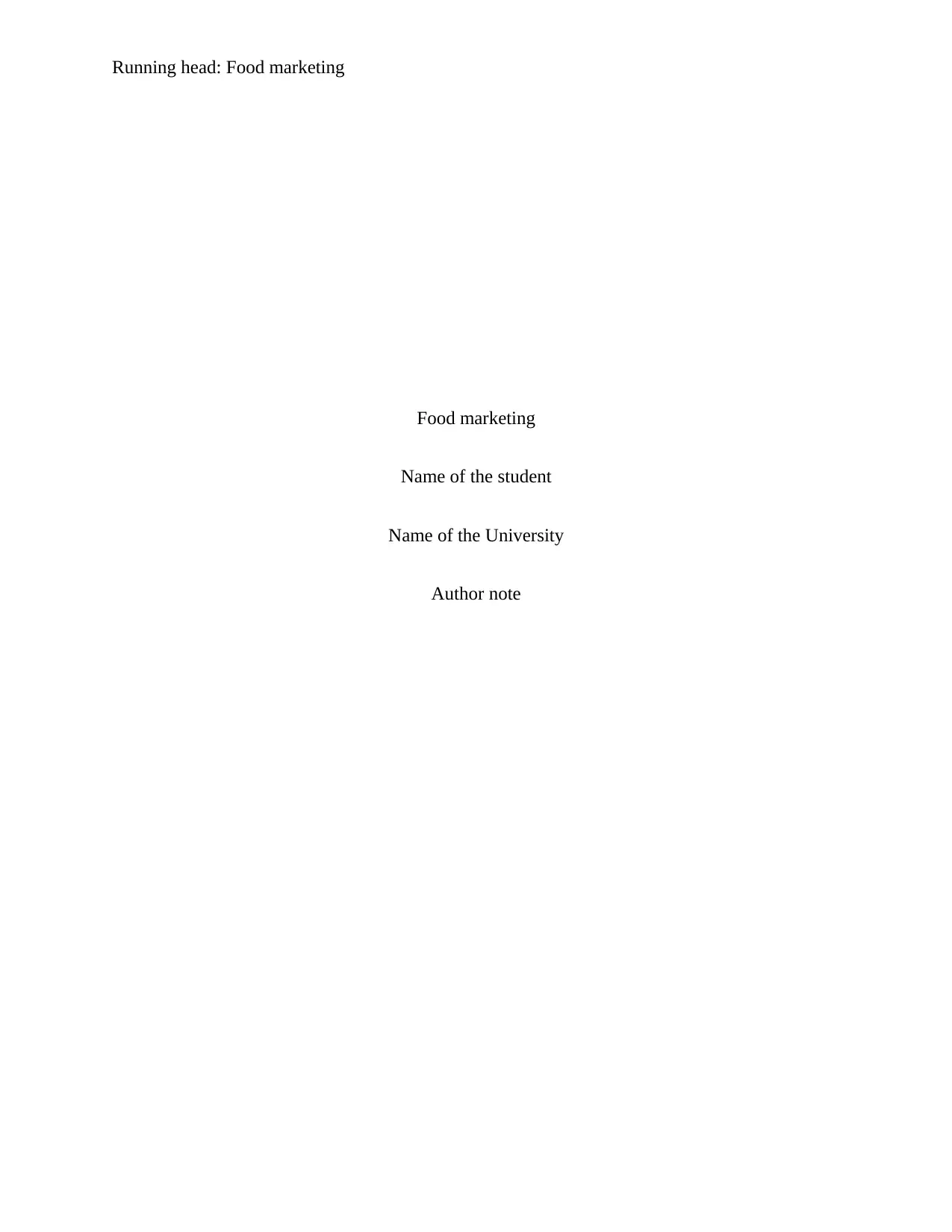
Running head: Food marketing
Food marketing
Name of the student
Name of the University
Author note
Food marketing
Name of the student
Name of the University
Author note
Paraphrase This Document
Need a fresh take? Get an instant paraphrase of this document with our AI Paraphraser
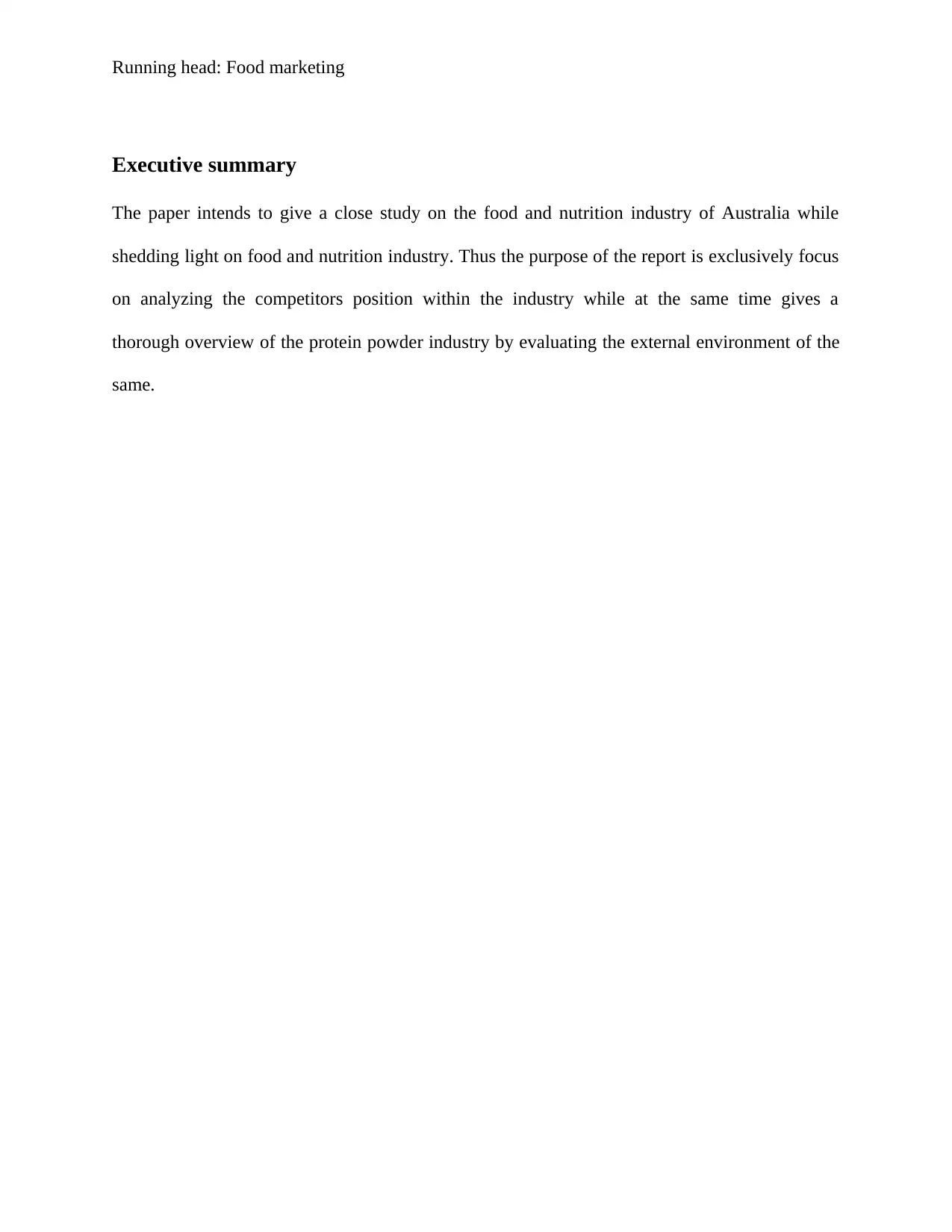
Running head: Food marketing
Executive summary
The paper intends to give a close study on the food and nutrition industry of Australia while
shedding light on food and nutrition industry. Thus the purpose of the report is exclusively focus
on analyzing the competitors position within the industry while at the same time gives a
thorough overview of the protein powder industry by evaluating the external environment of the
same.
Executive summary
The paper intends to give a close study on the food and nutrition industry of Australia while
shedding light on food and nutrition industry. Thus the purpose of the report is exclusively focus
on analyzing the competitors position within the industry while at the same time gives a
thorough overview of the protein powder industry by evaluating the external environment of the
same.
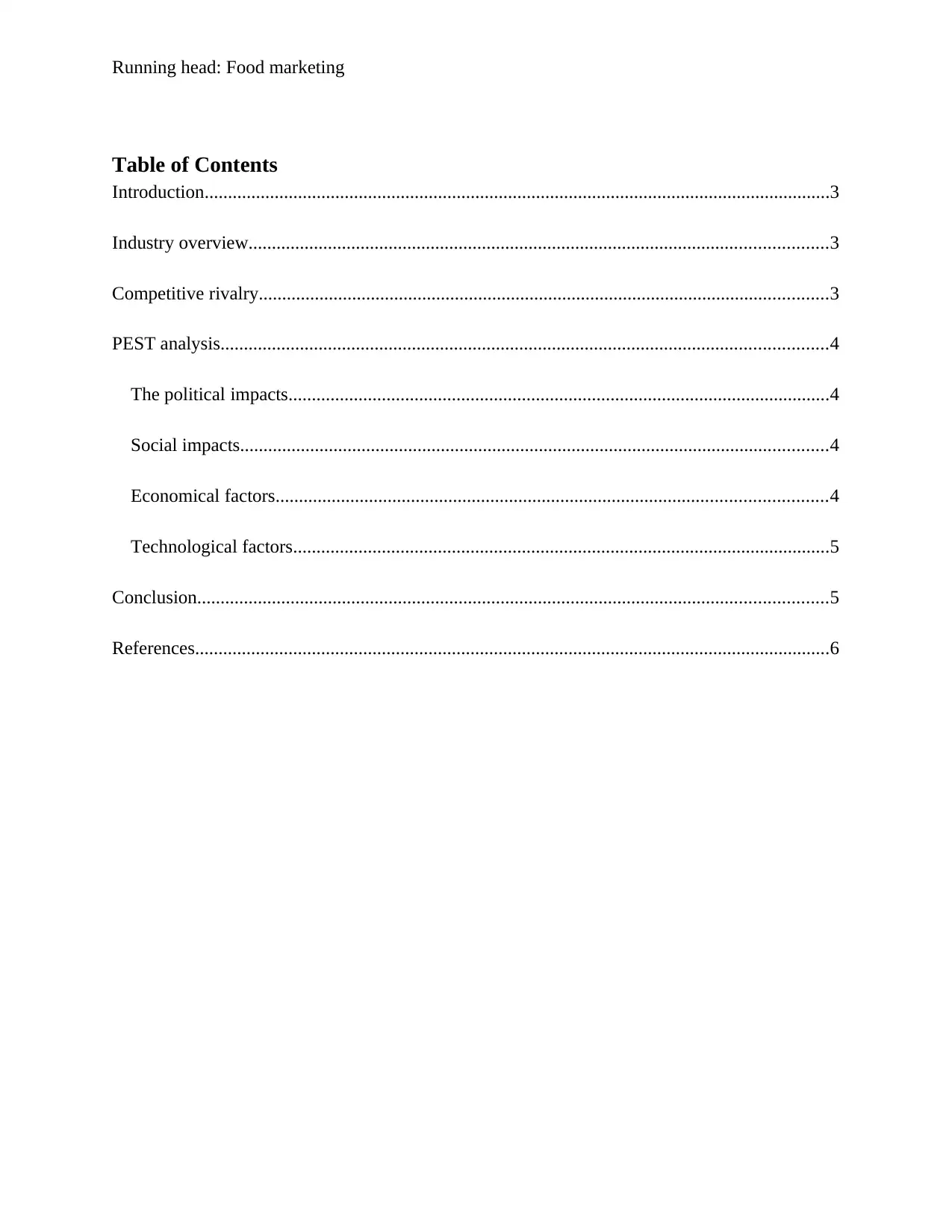
Running head: Food marketing
Table of Contents
Introduction......................................................................................................................................3
Industry overview............................................................................................................................3
Competitive rivalry..........................................................................................................................3
PEST analysis..................................................................................................................................4
The political impacts....................................................................................................................4
Social impacts..............................................................................................................................4
Economical factors......................................................................................................................4
Technological factors...................................................................................................................5
Conclusion.......................................................................................................................................5
References........................................................................................................................................6
Table of Contents
Introduction......................................................................................................................................3
Industry overview............................................................................................................................3
Competitive rivalry..........................................................................................................................3
PEST analysis..................................................................................................................................4
The political impacts....................................................................................................................4
Social impacts..............................................................................................................................4
Economical factors......................................................................................................................4
Technological factors...................................................................................................................5
Conclusion.......................................................................................................................................5
References........................................................................................................................................6
⊘ This is a preview!⊘
Do you want full access?
Subscribe today to unlock all pages.

Trusted by 1+ million students worldwide
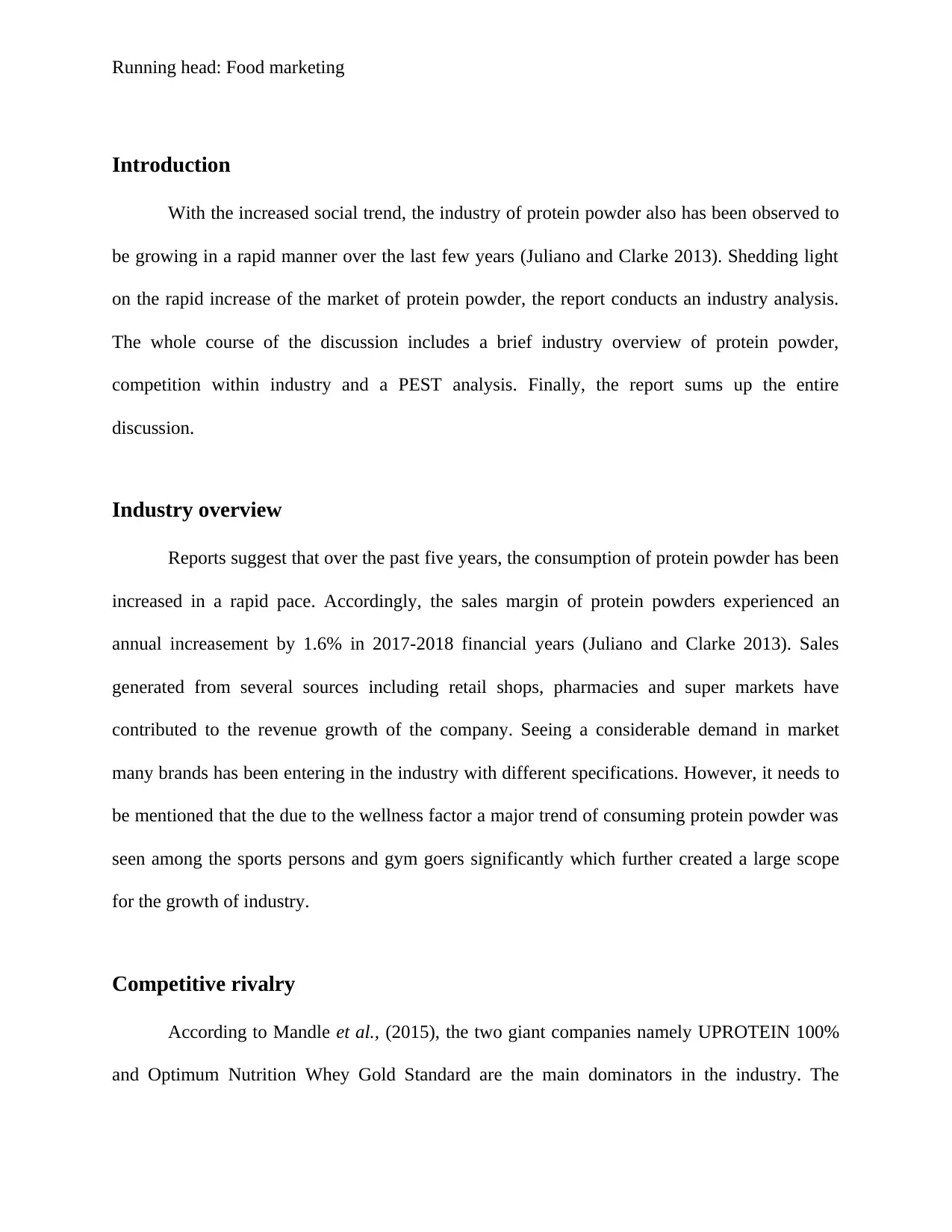
Running head: Food marketing
Introduction
With the increased social trend, the industry of protein powder also has been observed to
be growing in a rapid manner over the last few years (Juliano and Clarke 2013). Shedding light
on the rapid increase of the market of protein powder, the report conducts an industry analysis.
The whole course of the discussion includes a brief industry overview of protein powder,
competition within industry and a PEST analysis. Finally, the report sums up the entire
discussion.
Industry overview
Reports suggest that over the past five years, the consumption of protein powder has been
increased in a rapid pace. Accordingly, the sales margin of protein powders experienced an
annual increasement by 1.6% in 2017-2018 financial years (Juliano and Clarke 2013). Sales
generated from several sources including retail shops, pharmacies and super markets have
contributed to the revenue growth of the company. Seeing a considerable demand in market
many brands has been entering in the industry with different specifications. However, it needs to
be mentioned that the due to the wellness factor a major trend of consuming protein powder was
seen among the sports persons and gym goers significantly which further created a large scope
for the growth of industry.
Competitive rivalry
According to Mandle et al., (2015), the two giant companies namely UPROTEIN 100%
and Optimum Nutrition Whey Gold Standard are the main dominators in the industry. The
Introduction
With the increased social trend, the industry of protein powder also has been observed to
be growing in a rapid manner over the last few years (Juliano and Clarke 2013). Shedding light
on the rapid increase of the market of protein powder, the report conducts an industry analysis.
The whole course of the discussion includes a brief industry overview of protein powder,
competition within industry and a PEST analysis. Finally, the report sums up the entire
discussion.
Industry overview
Reports suggest that over the past five years, the consumption of protein powder has been
increased in a rapid pace. Accordingly, the sales margin of protein powders experienced an
annual increasement by 1.6% in 2017-2018 financial years (Juliano and Clarke 2013). Sales
generated from several sources including retail shops, pharmacies and super markets have
contributed to the revenue growth of the company. Seeing a considerable demand in market
many brands has been entering in the industry with different specifications. However, it needs to
be mentioned that the due to the wellness factor a major trend of consuming protein powder was
seen among the sports persons and gym goers significantly which further created a large scope
for the growth of industry.
Competitive rivalry
According to Mandle et al., (2015), the two giant companies namely UPROTEIN 100%
and Optimum Nutrition Whey Gold Standard are the main dominators in the industry. The
Paraphrase This Document
Need a fresh take? Get an instant paraphrase of this document with our AI Paraphraser
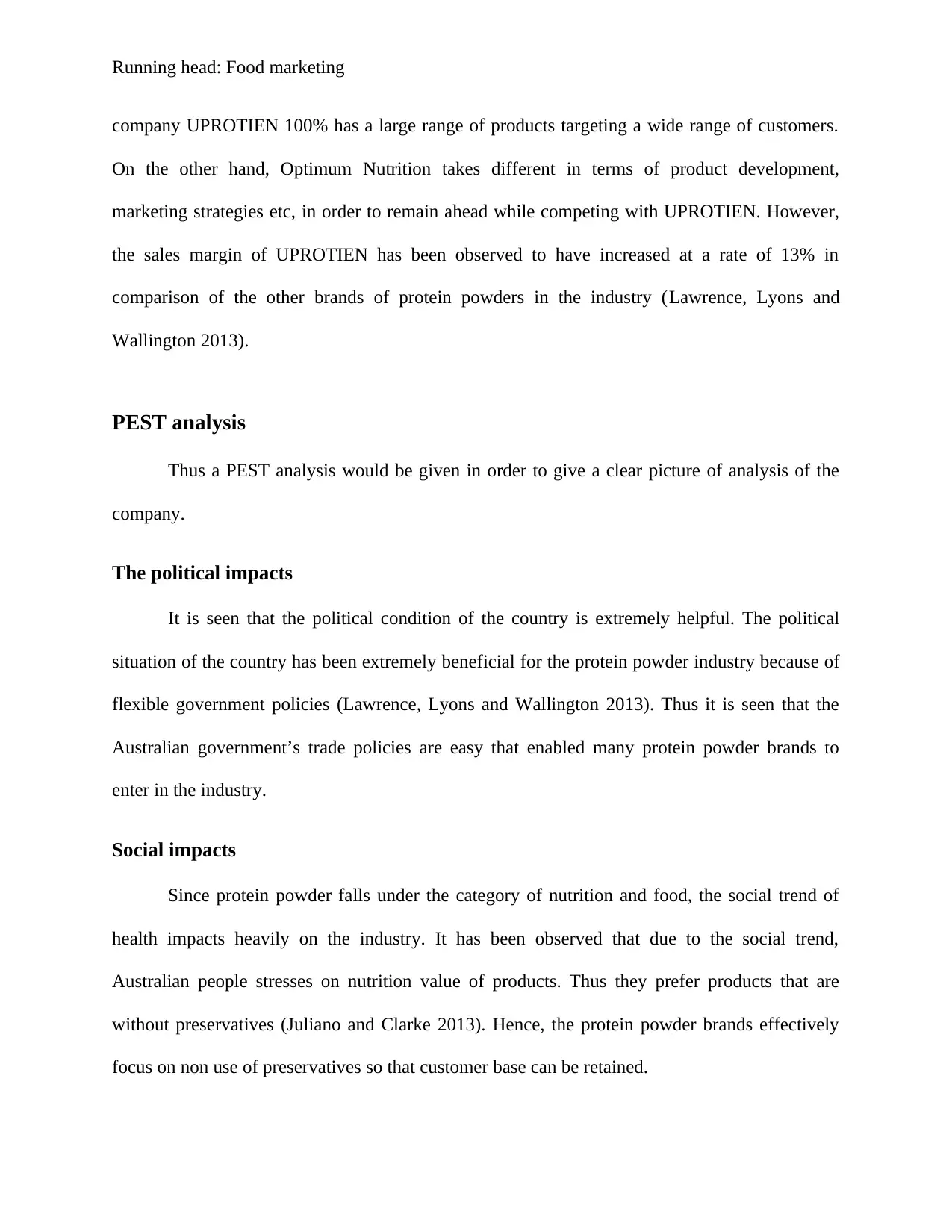
Running head: Food marketing
company UPROTIEN 100% has a large range of products targeting a wide range of customers.
On the other hand, Optimum Nutrition takes different in terms of product development,
marketing strategies etc, in order to remain ahead while competing with UPROTIEN. However,
the sales margin of UPROTIEN has been observed to have increased at a rate of 13% in
comparison of the other brands of protein powders in the industry (Lawrence, Lyons and
Wallington 2013).
PEST analysis
Thus a PEST analysis would be given in order to give a clear picture of analysis of the
company.
The political impacts
It is seen that the political condition of the country is extremely helpful. The political
situation of the country has been extremely beneficial for the protein powder industry because of
flexible government policies (Lawrence, Lyons and Wallington 2013). Thus it is seen that the
Australian government’s trade policies are easy that enabled many protein powder brands to
enter in the industry.
Social impacts
Since protein powder falls under the category of nutrition and food, the social trend of
health impacts heavily on the industry. It has been observed that due to the social trend,
Australian people stresses on nutrition value of products. Thus they prefer products that are
without preservatives (Juliano and Clarke 2013). Hence, the protein powder brands effectively
focus on non use of preservatives so that customer base can be retained.
company UPROTIEN 100% has a large range of products targeting a wide range of customers.
On the other hand, Optimum Nutrition takes different in terms of product development,
marketing strategies etc, in order to remain ahead while competing with UPROTIEN. However,
the sales margin of UPROTIEN has been observed to have increased at a rate of 13% in
comparison of the other brands of protein powders in the industry (Lawrence, Lyons and
Wallington 2013).
PEST analysis
Thus a PEST analysis would be given in order to give a clear picture of analysis of the
company.
The political impacts
It is seen that the political condition of the country is extremely helpful. The political
situation of the country has been extremely beneficial for the protein powder industry because of
flexible government policies (Lawrence, Lyons and Wallington 2013). Thus it is seen that the
Australian government’s trade policies are easy that enabled many protein powder brands to
enter in the industry.
Social impacts
Since protein powder falls under the category of nutrition and food, the social trend of
health impacts heavily on the industry. It has been observed that due to the social trend,
Australian people stresses on nutrition value of products. Thus they prefer products that are
without preservatives (Juliano and Clarke 2013). Hence, the protein powder brands effectively
focus on non use of preservatives so that customer base can be retained.
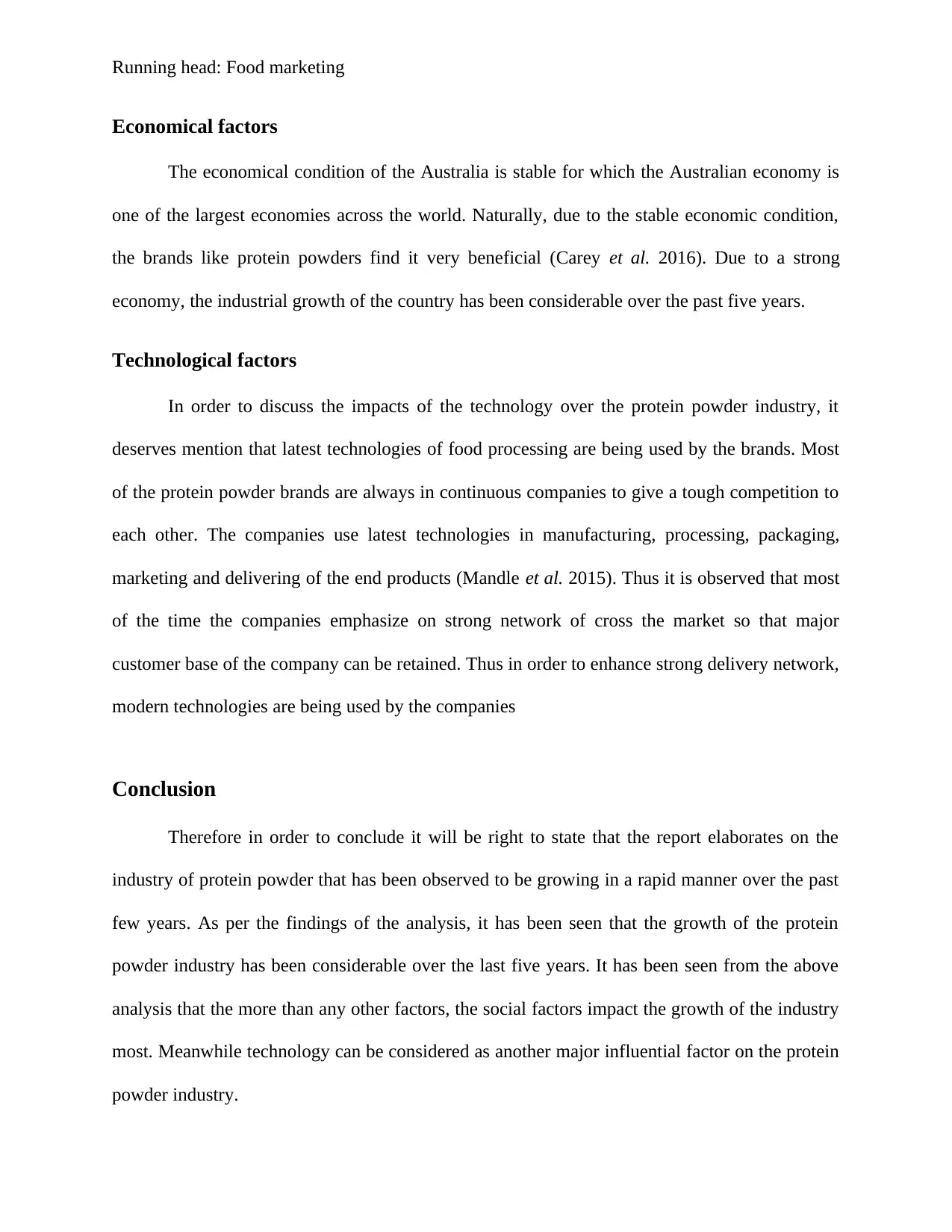
Running head: Food marketing
Economical factors
The economical condition of the Australia is stable for which the Australian economy is
one of the largest economies across the world. Naturally, due to the stable economic condition,
the brands like protein powders find it very beneficial (Carey et al. 2016). Due to a strong
economy, the industrial growth of the country has been considerable over the past five years.
Technological factors
In order to discuss the impacts of the technology over the protein powder industry, it
deserves mention that latest technologies of food processing are being used by the brands. Most
of the protein powder brands are always in continuous companies to give a tough competition to
each other. The companies use latest technologies in manufacturing, processing, packaging,
marketing and delivering of the end products (Mandle et al. 2015). Thus it is observed that most
of the time the companies emphasize on strong network of cross the market so that major
customer base of the company can be retained. Thus in order to enhance strong delivery network,
modern technologies are being used by the companies
Conclusion
Therefore in order to conclude it will be right to state that the report elaborates on the
industry of protein powder that has been observed to be growing in a rapid manner over the past
few years. As per the findings of the analysis, it has been seen that the growth of the protein
powder industry has been considerable over the last five years. It has been seen from the above
analysis that the more than any other factors, the social factors impact the growth of the industry
most. Meanwhile technology can be considered as another major influential factor on the protein
powder industry.
Economical factors
The economical condition of the Australia is stable for which the Australian economy is
one of the largest economies across the world. Naturally, due to the stable economic condition,
the brands like protein powders find it very beneficial (Carey et al. 2016). Due to a strong
economy, the industrial growth of the country has been considerable over the past five years.
Technological factors
In order to discuss the impacts of the technology over the protein powder industry, it
deserves mention that latest technologies of food processing are being used by the brands. Most
of the protein powder brands are always in continuous companies to give a tough competition to
each other. The companies use latest technologies in manufacturing, processing, packaging,
marketing and delivering of the end products (Mandle et al. 2015). Thus it is observed that most
of the time the companies emphasize on strong network of cross the market so that major
customer base of the company can be retained. Thus in order to enhance strong delivery network,
modern technologies are being used by the companies
Conclusion
Therefore in order to conclude it will be right to state that the report elaborates on the
industry of protein powder that has been observed to be growing in a rapid manner over the past
few years. As per the findings of the analysis, it has been seen that the growth of the protein
powder industry has been considerable over the last five years. It has been seen from the above
analysis that the more than any other factors, the social factors impact the growth of the industry
most. Meanwhile technology can be considered as another major influential factor on the protein
powder industry.
⊘ This is a preview!⊘
Do you want full access?
Subscribe today to unlock all pages.

Trusted by 1+ million students worldwide
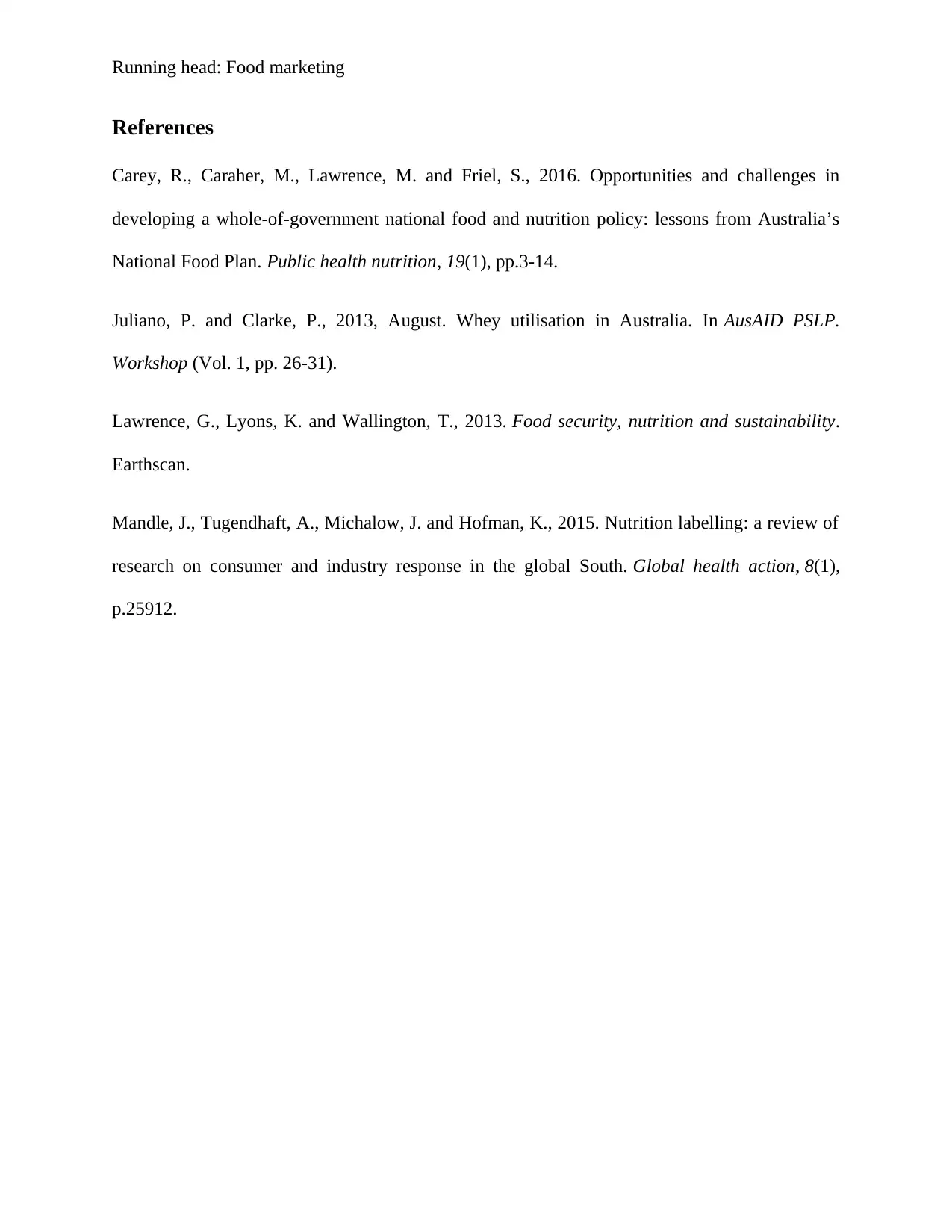
Running head: Food marketing
References
Carey, R., Caraher, M., Lawrence, M. and Friel, S., 2016. Opportunities and challenges in
developing a whole-of-government national food and nutrition policy: lessons from Australia’s
National Food Plan. Public health nutrition, 19(1), pp.3-14.
Juliano, P. and Clarke, P., 2013, August. Whey utilisation in Australia. In AusAID PSLP.
Workshop (Vol. 1, pp. 26-31).
Lawrence, G., Lyons, K. and Wallington, T., 2013. Food security, nutrition and sustainability.
Earthscan.
Mandle, J., Tugendhaft, A., Michalow, J. and Hofman, K., 2015. Nutrition labelling: a review of
research on consumer and industry response in the global South. Global health action, 8(1),
p.25912.
References
Carey, R., Caraher, M., Lawrence, M. and Friel, S., 2016. Opportunities and challenges in
developing a whole-of-government national food and nutrition policy: lessons from Australia’s
National Food Plan. Public health nutrition, 19(1), pp.3-14.
Juliano, P. and Clarke, P., 2013, August. Whey utilisation in Australia. In AusAID PSLP.
Workshop (Vol. 1, pp. 26-31).
Lawrence, G., Lyons, K. and Wallington, T., 2013. Food security, nutrition and sustainability.
Earthscan.
Mandle, J., Tugendhaft, A., Michalow, J. and Hofman, K., 2015. Nutrition labelling: a review of
research on consumer and industry response in the global South. Global health action, 8(1),
p.25912.
1 out of 7
Related Documents
Your All-in-One AI-Powered Toolkit for Academic Success.
+13062052269
info@desklib.com
Available 24*7 on WhatsApp / Email
![[object Object]](/_next/static/media/star-bottom.7253800d.svg)
Unlock your academic potential
Copyright © 2020–2025 A2Z Services. All Rights Reserved. Developed and managed by ZUCOL.





